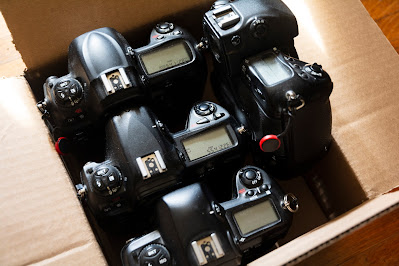It's midafternoon, I'm sitting out front of Fat Dan's on College Avenue, and here comes that gorgeous Elm Green Volkswagen Karmann Ghia!
The first time is August 31st, and I've got the Nikon D700 wearing the compact 28-200mm f/3.5-5.6G super zoom.
The D700 came out in 2008 and packed the 12MP full-frame CMOS sensor and EXPEED processor of the previous year's pro D3 camera into a smaller body. Priced at $2999, two grand less than the D3, it lost some features, like the vertical grip and larger battery, the second card slot, and was downgraded from 9fps to 5fps, but it was still ruggedized and weather sealed.
The 28-200 lens mounted on it favors compactness and focal length range over ultimate optical performance, but it's a Nikon and still does a pretty good job.
This was shot at a focal length of 95mm in Program mode with the camera set at its base ISO of 200, and the camera went with 1/400th of a second at f/10.
About a month later, early October, I'm sitting the same place around the same time when here comes the Karmann Ghia again!
This time I had a Canon EOS-1D Mark IV with the excellent EF 24-105mm f/4L IS general purpose zoom lens mounted.
Released in 2009, the $4999 EOS-1D Mark IV was Canon's top-of-the-line pro camera aimed at sports and wildlife photographers and photojournalists. It had a 16MP APS-H sensor, slightly smaller than the full frame one the company used in its studio & landscape oriented -1Ds series. This is because it prioritized frame rate; the Mark IV could blaze away at 10fps until the buffer filled.
The 24-105/4 "L"-series lens has a field of view equivalent to a 31-137mm lens on the 1D, due to the 1.3x crop factor of the APS-H sensor.
I was shooting in Aperture Priority mode at f/5.6 to ensure reasonably fast shutter speeds at the base ISO of 100 in the late afternoon sunlight.
Both images were shot in RAW and minimally processed through Photoshop's Camera RAW convertor.
It's interesting that a decade and a half on, the prices of the cameras have decreased dramatically, but the relative price gap remains fairly consistent. Nice used D700s are running around $300-400, while a 1D4 is still going to set you back six or seven hundred bucks.
Both lenses are discontinued. The 24-105mm f/4L IS has been replaced with a "Mark II" version. The handy little 28-200mm f/3.5-5.6G, a marvel when it was released, lacks an internal focusing motor or any kind of stabilization, and is therefore not amenable to being used on mirrorless cameras or most Nikon DX DSLRs.
It's fun to use these old pro cameras I never could have afforded when they were new. They were built to last and plenty were traded in with a lot of life left in them. There are D700s running out there with a million documented shutter actuations; if you run across a used one with only a few thousand on the clock, it's barely broken in.
.













